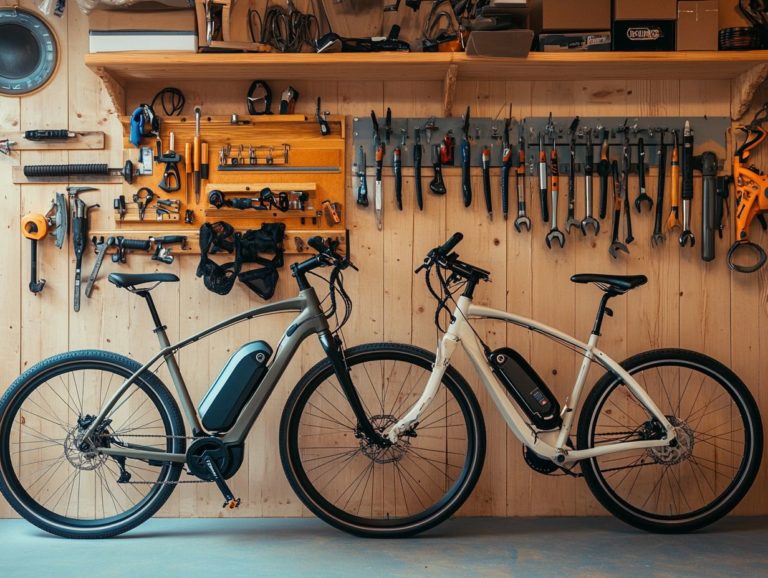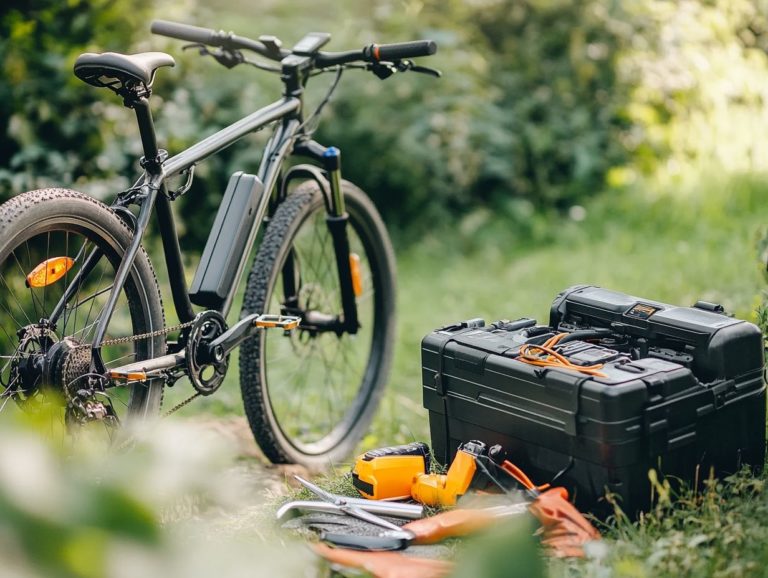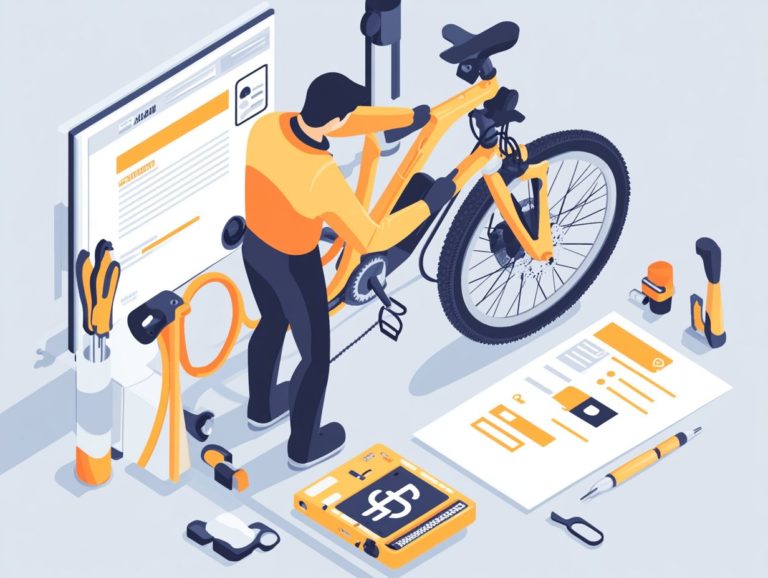Can You Ride Electric Bicycles in the Rain?
Electric bicycles have revolutionized your commuting and exploring experience, seamlessly merging traditional cycling with the power of electric assistance.
But what do you do when the skies decide to pour?
This article delves into everything you need to know about electric bicycles, including how to keep them safe and functional during those rainy excursions.
Uncover essential weatherproofing techniques, discover riding tips tailored for wet conditions, and learn maintenance strategies designed to ensure longevity.
Embrace the elements and ride with confidence, regardless of the weather!
Contents
- Key Takeaways:
- Understanding Electric Bicycles
- Weatherproofing Your Electric Bicycle
- Can Electric Bicycles be Used in the Rain?
- Riding Tips for Wet Weather
- Maintenance for Electric Bicycles in the Rain
- Waterproofing Accessories for Electric Bicycles
- Frequently Asked Questions
- Can You Ride E-bikes in the Rain?
- What Precautions Should I Take When Riding an E-bike in the Rain?
- Are E-bikes More Dangerous to Ride in the Rain Compared to Regular Bicycles?
- Do I Need to Do Any Maintenance on My E-bike After Riding in the Rain?
- Can I Ride My E-bike in Heavy Rain or Thunderstorms?
- What Should I Do If My E-bike Gets Wet While I’m Riding in the Rain?
Key Takeaways:
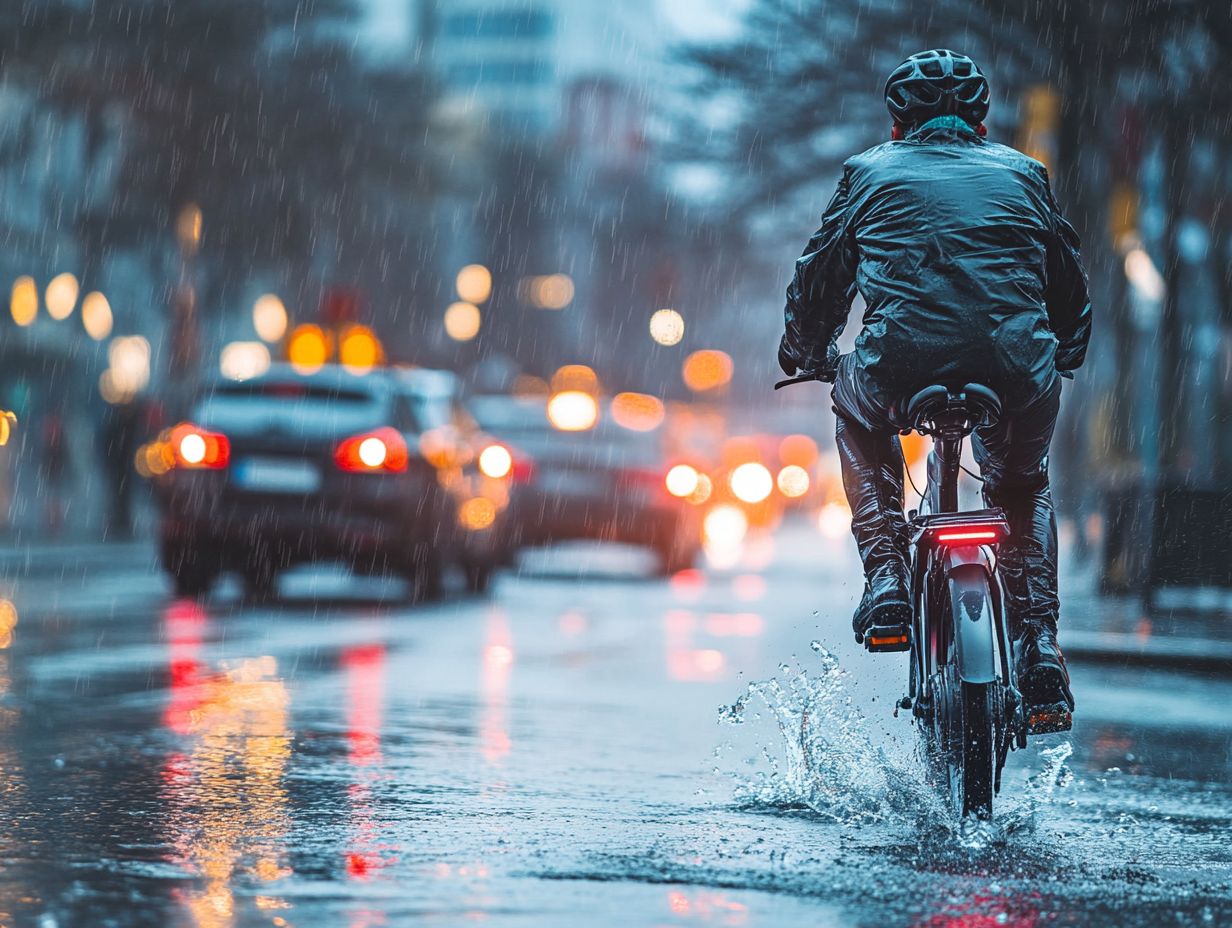
Understanding Electric Bicycles
Understanding electric bicycles, or e-bikes, requires diving into their key components, such as the motor, battery, and various mechanical parts that together define their performance. These bikes have surged in popularity due to their ability to deliver a smooth and enjoyable riding experience, making them an ideal choice for both commuters and recreational riders.
With technological advancements, today’s e-bikes boast features that significantly enhance safety and comfort while riding, particularly in diverse weather conditions. Understanding whether electric bicycles can be ridden off-road is crucial for you to ride and maintain e-bikes responsibly.
What are Electric Bicycles?
Electric bicycles, or e-bikes, are your new best friends on two wheels. With an electric motor to assist with propulsion, they allow you to zip through your ride at higher speeds without breaking a sweat.
These cutting-edge machines come in a variety of styles, each tailored to meet your specific riding needs and preferences. Whether you’re a city commuter looking for a swift and efficient way to get around or a mountain enthusiast craving an adrenaline rush on rugged trails, e-bikes elevate your riding experience to new heights.
For example, city e-bikes often feature lightweight frames and integrated lights, making them ideal for weaving through urban landscapes. On the other hand, mountain e-bikes are built tough, equipped with advanced suspension systems that let you tackle challenging terrains with confidence.
The beauty of these electric bicycles lies not just in their functionality; they simplify your journeys and inspire an active lifestyle, opening up the world of cycling to an even wider audience.
Weatherproofing Your Electric Bicycle
Weatherproofing your electric bicycle is essential for maintaining its longevity and optimal performance. When confronted with rain and other challenging conditions, taking the necessary precautions can protect its various components from potential damage.
Important Components to Protect
When you’re weatherproofing your electric bicycle, it’s crucial to safeguard key components like the motor, battery, and electrical system. Water exposure can seriously compromise their functionality.
These vital parts are vulnerable to corrosion, short-circuiting, and performance degradation when wet, which could lead to some rather expensive repairs or replacements. Take the battery, for example, often the priciest part of the bike. If moisture manages to seep into its casing, you might find yourself dealing with reduced power output or even a complete failure. If you’re wondering about using your bike in wet conditions, check out this guide on using your electric bicycle in winter.
The motor, which powers your ride, isn’t off the hook either; it can suffer from friction issues and electrical malfunctions if it’s not adequately shielded from rain and debris. To keep these components safe from the elements, invest in proper seals and protective coverings, and make routine maintenance a priority. For specific guidance, check out our article on how to maintain your electric bicycle after rain. This proactive approach will help ensure your electric bicycle remains reliable and extends its lifespan.
Can Electric Bicycles be Used in the Rain?

Electric bicycles can certainly handle rainy weather. However, take precautions now to ensure your ride is safe and enjoyable!
Factors to Consider
When considering riding an electric bicycle in the rain, focus on speed control and effective braking to stay safe.
Understanding how to navigate slick, wet roads is crucial for preventing accidents. Maintain a reduced speed to enhance your control and give yourself ample reaction time when unexpected obstacles appear.
Invest in high-quality tires designed for rainy conditions to improve your grip and stability. Use proper hand signals and visibility gear, as rain can significantly reduce sightlines.
By focusing on these factors, you can ensure your ride remains safe and enjoyable, even when the weather challenges you.
Riding Tips for Wet Weather
Navigating wet weather requires specific strategies to elevate your safety and ensure a pleasurable ride. With slippery surfaces posing a risk, be well-prepared.
How to Stay Safe and Dry
To keep yourself safe and dry while riding your electric bicycle in the rain, invest in quality waterproof and protective gear, like jackets and pants made for wet conditions.
Also, consider waterproof shoes and gloves to protect against the elements, ensuring every ride remains comfortable. This gear is often crafted from advanced breathable materials that keep moisture out while allowing perspiration to escape.
Regular maintenance is key. Clean and treat the fabric with specialized sprays to preserve durability and functionality. This care extends the lifespan of your gear and optimizes its performance, keeping you dry and safe in unpredictable conditions.
Maintenance for Electric Bicycles in the Rain
Maintaining your electric bicycle in rainy conditions is crucial for preventing damage and ensuring how long important parts last, like the electrical system and drivetrain.
By taking necessary precautions, you safeguard your investment and enhance your bike’s overall performance.
Preventing Damage and Ensuring Longevity
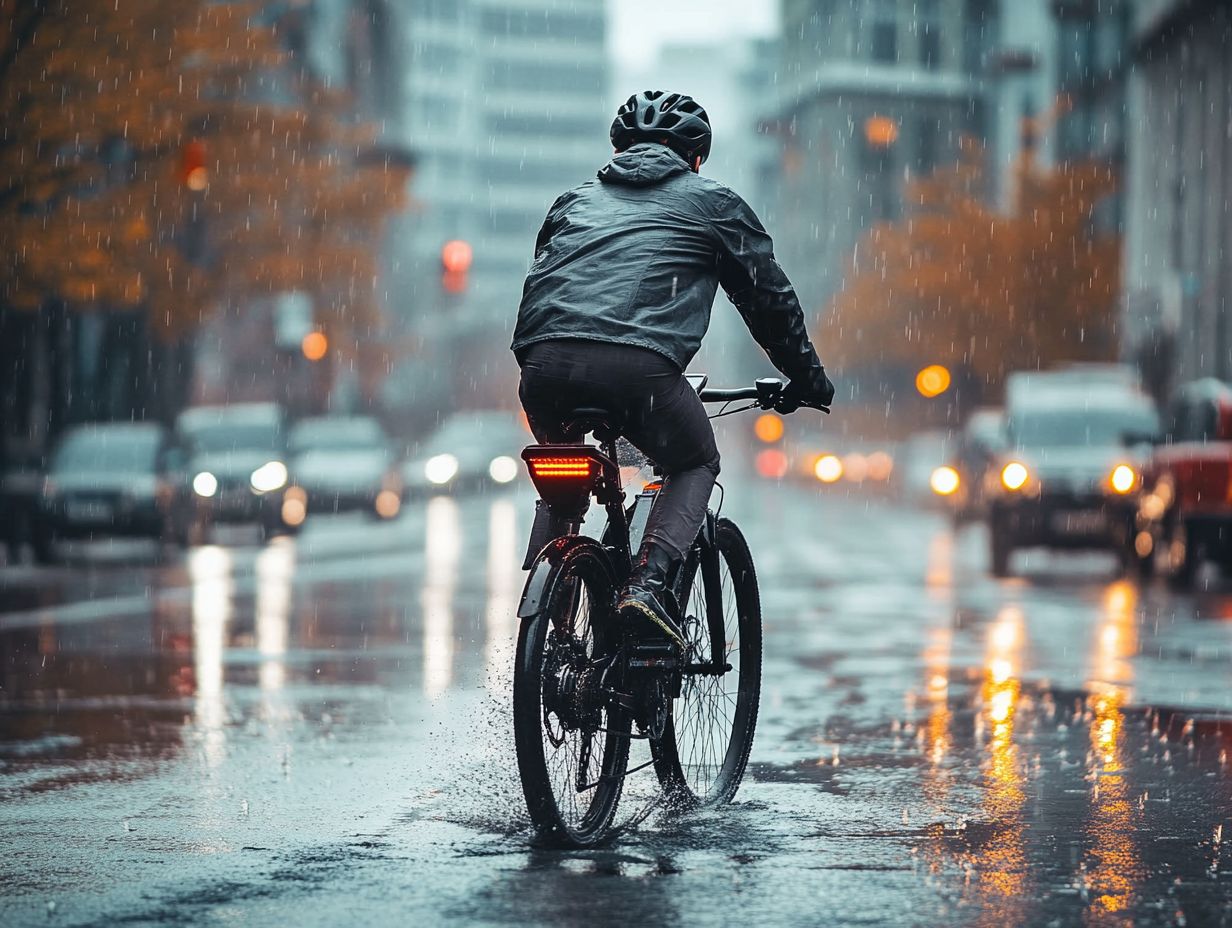
To protect your electric bicycle and enhance its longevity, adopt practices like ensuring proper storage and avoiding pressure-washing, which can damage sensitive components.
Approach cleaning with care. Use a soft cloth and biodegradable soap instead of harsh chemicals that could cause harm. Regular servicing is also vital to ensure all mechanical parts operate efficiently, helping you avoid costly repairs in the future.
Store your bike in a dry, shaded area to protect delicate electronic components from moisture and shield the frame from the elements. To enhance your bike’s resilience during wet conditions, consider exploring the best electric bicycle accessories for rainy days. Make sure to regularly check tire pressure, battery levels, and chain lubrication to keep your bike performing at its best.
Waterproofing Accessories for Electric Bicycles
Utilizing waterproofing accessories for your electric bicycle can greatly enhance your riding experience, providing robust protection against rain and wet conditions.
With these enhancements, you ll ride with confidence, knowing that you’re prepared for whatever the weather throws your way. Gear up and ride safely in any weather!
Recommended Gear for Rainy Rides
Invest in high-quality waterproof gear for rainy rides. This includes jackets and fenders that enhance your safety and comfort.
Choose high-performance waterproof jackets. They keep you dry and use breathable materials that allow sweat to escape, helping you stay comfortable. The reflective elements in these jackets significantly improve your visibility, ensuring you re seen by others even in low-light conditions.
Pair these jackets with dependable fenders to protect yourself from splashes and mud. Premium fenders keep you dry and reduce the maintenance required for your bike, extending the lifespan of its components.
By incorporating such gear into your cycling arsenal, you can confidently tackle wet journeys. Get ready to face the rain like a pro!
Frequently Asked Questions
Can You Ride E-bikes in the Rain?
Absolutely! You can ride e-bikes in the rain if they’re waterproof and you ve got the right gear on.
What Precautions Should I Take When Riding an E-bike in the Rain?
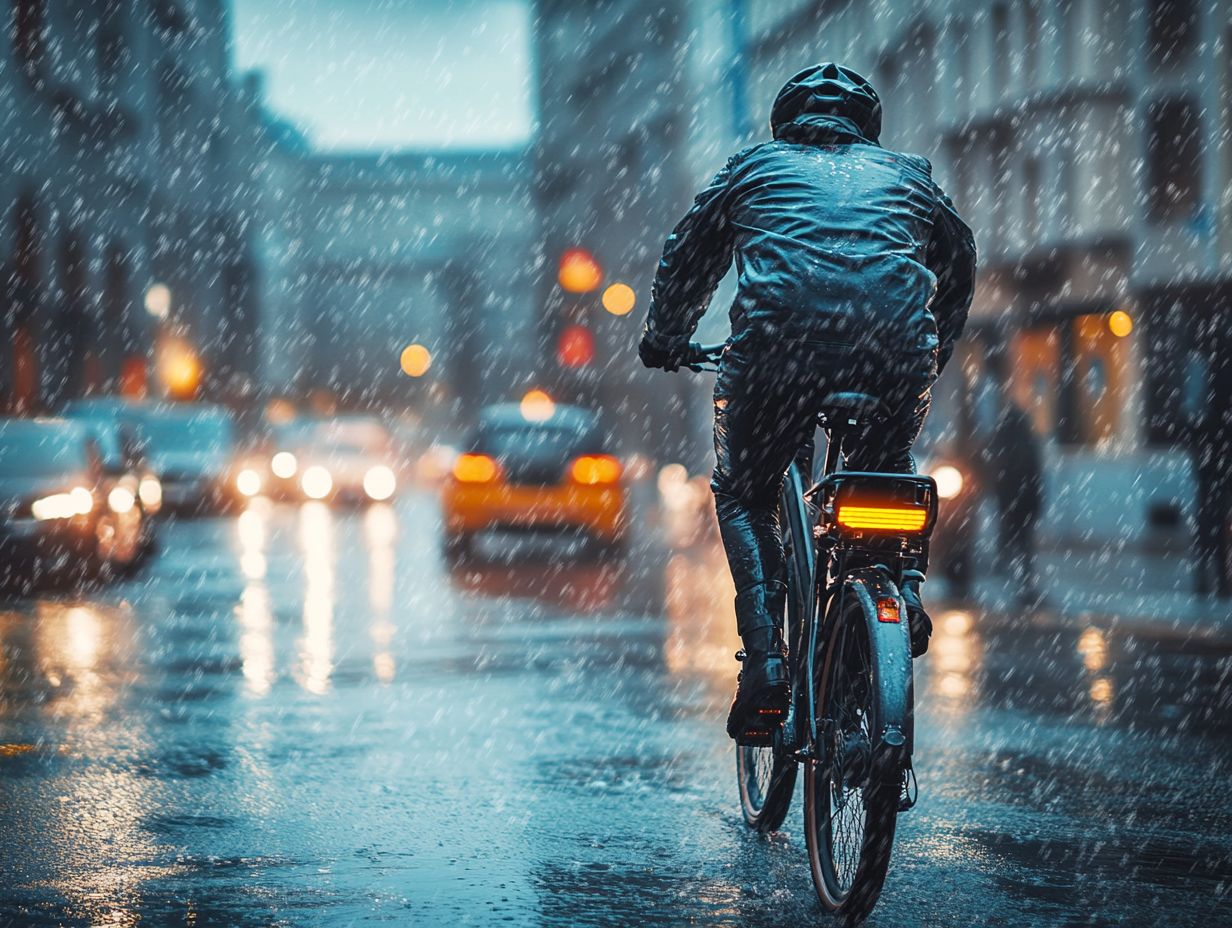
When riding an electric bicycle in the rain, wear appropriate rain gear. Ensure that your bike’s electric components are well protected, and avoid deep puddles or flooded areas.
Are E-bikes More Dangerous to Ride in the Rain Compared to Regular Bicycles?
Not necessarily. With the right precautions and a well-maintained bike, riding an electric bicycle in the rain can be just as safe as riding a regular bicycle.
Do I Need to Do Any Maintenance on My E-bike After Riding in the Rain?
It s a good idea to check and dry off your bike after riding in the rain, especially the electric components. This helps prevent potential damage or malfunction from water exposure.
Can I Ride My E-bike in Heavy Rain or Thunderstorms?
It’s not recommended to ride in extremely heavy rain or during thunderstorms. Doing so can be dangerous for you and your bike. Wait until the weather clears before riding again.
What Should I Do If My E-bike Gets Wet While I’m Riding in the Rain?
If your electric bicycle gets wet while riding, stop and seek shelter. Once the rain has stopped, thoroughly dry off your bike and check for any potential water damage. If you suspect water damage, it s wise to have your bike inspected by a professional.

